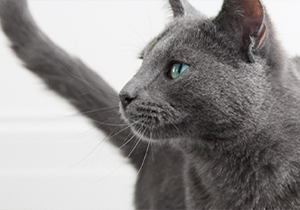Causes Of Seizures In Cats
As cat parents, we are constantly worried about the general health and well-being of our majestic furballs, and watching our felines in physical distress and pain can be extremely upsetting for us all. And it is all the more frightening to see your kitty experience concerning health disorders such as seizures in cats and epileptic attacks.
Epileptic attacks, or seizures are a result of temporary disturbances in the normal electrical functioning of the brain, and may involve stiffening or uncontrollable jerking of the body. And although witnessing your royal furry experience an episode of seizures is extremely scary and disturbing, it is important to keep calm. Not all epileptic attacks or seizures in cats are life-threatening or call for an emergency, so keeping yourself composed and treating your furry feline with the necessary attention can be extremely helpful.
This article discusses the common reasons for seizures and epileptic attacks and tips on alleviating your cat's distress.
What are Seizures in Cats?

Most cat parents grow extremely anxious seeing their feline in physical anguish and distress, and watching them suffer an epileptic period can leave cat parents scared. So, it is important to generate awareness about the cat seizure causes and cat seizure what to do in cramped cats, and how they can be treated.
Seizures in cats can cause uncontrollable shaking and stiffening of their body, and in severe cases, may even lead to involuntary urination as well as loss of consciousness. Seizures can also be identified as convulsions or fit, resulting from a disruption in the electrical activity of the brain. Additionally, trauma injuries or tumours in the cramped cat brain can also cause twitching, shaking, and spasms.
While dogs are more frequent to episodes of convulsion and twitching, cats can also experience seizures, although there might not always be any detectable cause. Such cases of seizures in cats are known as idiopathic epilepsy.
Types Of Seizures In Cats
Uncontrollable shaking and twitching are telltale signs of fits in cats, but it would be unwise to categorise them into a single type as not all seizures have violent or obvious reactions.
-
Focal Seizures/Partial Motor Seizures
Of the types of seizures cats are most likely to experience, focal or partial motor seizures are the most common. Focal seizures are known to affect a certain focussed area of the brain, and although not violent, can result in cat seizure symptoms like twitching of the whiskers, mouth and eyes, as well as ear flicking making it important to know cat seizure what to do.
-
Generalized Seizures/Grand Mal Seizures
Although rare, grand mal seizures in cats or generalized seizures in cats are concerning situations which can impact a considerably larger area of the brain, leading to involuntary twitching and convulsions. Grand mal seizures in cats are violent in nature, and can result in a loss of body functions, and even consciousness. Severe cases of generalised seizures are marked by a loss of control over bodily functions, resulting in involuntary urinating or defecating, or drooling, and is vital for cat parents to know cat seizure what to do.
-
Psychomotor Seizures/Complex Partial Seizures
Cats are also known to experience psychomotor or complex partial seizures, which might not lead to life-threatening situations, but can be substantially annoying and uncomfortable for cats. Psychomotor seizures or fits in cats can lead to weird behaviours such as unprompted growling and loud vocalizations, random bursts of physical activities like running, or violently chewing at the skin or tail.
Knowing the pattern or type of seizures in cramped cats your feline furry friend is suffering from can be helpful in easy diagnoses, allowing your royal furry to receive the necessary healthcare at the earliest.
What Causes Seizures in Cats?
Here are some common cat seizure causes.
-
Toxins
Convulsions and seizures in cats are commonly a result of reactions in the body triggered by various toxins. Accidentally ingesting antifreeze toxins such as ethylene glycol, or neurotoxic substances present in rat poison can have behaviour-modifying reactions in cats. Permethrin toxicity, often caused when dog flea-prevention products are applied to cats, can lead to an episode of fits in cats.
-
Hypoglycaemia
Hypoglycaemia in furry felines is characterized by a sudden drop in the glucose levels of the blood, which can lead to exhaustion, weakness, behavioural changes, and even stupor. Severe cases of hypoglycaemia can disrupt the circulation of glucose to muscles and adipose tissues in cats, leading to seizures, fits in cats and convulsions.
-
Loud Noises and Bright Lights
Any sudden change in their immediate surrounding can stimulate cats, leading to an imbalance in the hormones produced by their brains. Changes in their stimuli, such as bright lights or loud noises can trigger a reflex epilepsy in cats provoked by a sensory overload, leading to seizures, convulsions and even loss of consciousness.
-
Metabolic Diseases and Epilepsy
Although brain diseases are regarded as the most common cat seizure causes, epilepsy in cats attacks can also stem from other health and metabolic concerns, such as liver and kidney disorders. Metabolic disorders are often responsible for altering the composition of blood in cats, and can cause seizures and convulsions even if your cat has a healthy brain.
-
Brain Disease
Brain diseases are some of the leading reasons behind any electrical functional disorder leading to an episode of seizure in cats. Chemical imbalances caused by brain diseases can disrupt the balance between inhibitory and excitatory signals in cats, leading to epilepsy in cats. It is important to diagnose brain diseases early to ensure your feline receive timely cat seizure treatment.
-
Heat
While the occurrences of seizures in cats caused by heat are considerably fewer, they can pose a significant threat if left unchecked. Heat strokes in cats causes the internal body temperature to rise sharply without a release, leading to heat exhaustion and seizures, which can result in a loss of consciousness and even mortal injury.
What to Do When a Cat Has a Seizure?

If you are worried about what to do during cat seizures, here are some factors to keep in mind if your cramped cat experiences convulsions.
- If your cat has a seizure episode with cat seizure symptoms lasting longer than 2 to 3 minutes, or has multiple seizures in a row, consider looking up emergency care.
- Not all episodes of seizures in cramped cats are life threatening. However, status epilepticus is a severe condition accompanied by elevated body temperatures, and requires immediate healthcare to prevent comatose, swelling of the brain, or even death.
- Seizures cause your mystical little feline to feel confused, and scared. So, it is extremely beneficial to treat them gently in a calm way for assurance and faster recovery.
- Prolonged seizures or convulsions can cause stomach upset and induce vomiting in cats. So, following a seizure, it is important to feed them food and water in controlled portions.
Can You Prevent Seizures in Cats?
There are not many failsafe ways to prevent epileptic attacks or natural remedies for cat seizures. Here are some ways that can help you soothe convulsive cats:
- It is important to get medical care if your cat experiences seizures on a regular basis, or has multiple epileptic attacks within a span of 6 to 8 weeks.
- There are limited cat seizure treatments and home remedies for cat seizures available and they cannot guarantee a complete prevention of seizures in cats.
- If your feline munchkin has a history of epileptic attacks and convulsions, in addition to offering home remedies for cat seizures, frequently monitoring its general health for anomalies, therapies, and metabolic status is essential.
- Seizures in cats are also often induced by stress and duress in cats. Keeping your feline furry in a calm, stress free environment and conducive of a healthy, happy life can lower the frequency and duration, as well as eliminate the potential causes of cat seizure.
FAQs
-
What can trigger a seizure in cats?
Seizures in cats can be triggered by several reasons, such as toxins, metabolic disorders, heat strokes, and hypoglycaemia. However, a disruption of brain functions and sensory overload caused by sudden loud noises or bright lights are the most common triggers or causes of cat seizures.
-
What should I do if my cat has a seizure?
Are you worried about cat seizures what to do or looking for natural remedies for cat seizures? There are no natural remedies for cat seizures. So, if your convulsive cat has seizures for a long time, consult a veterinary.
-
Should I be worried if my cat has a seizure?
Wondering cat seizures what to do? Most cases of seizures are non-violent, so, it is important to stay calm and offer plenty of affection and reassurance to your dearest convulsive cat to help them recuperate and alleviate the shock.
-
Can cat seizures be cured?
Most cat parents worry about how to deal with seizures and look for natural remedies for cat seizures. While there are limited cat seizure treatment or home remedies for cat seizures, none of them can guarantee a complete prevention or cure of seizures.
-
Can seizures cause death in cats?
Although most epileptic attacks are non-violent without any threat to life, seizures in cats caused by heat strokes or conditions like status epilepticus are reported to have caused death in convulsive cats. So, it is important to watch out for frequent seizures.



 Share
Share







